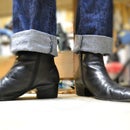Introduction: IPhone 5 Case, of Leather and Titanium
I wanted a very thin leather case for my iPhone 5. Most of the ones I've seen either offer little protection or add bulk by trying to be a wallet and not quite making it. While this case does not replace a wallet (I carry a lot of cards and I use my phone a lot, I don't want to be whipping-out my wallet every time I use it) it does have places for cash, and my business card. The titanium core provides a three-point grip on the phone, not obstructing any ports or buttons (save for the earphone jack which I rarely use, but is exposed in the second iteration.)
Step 1: You Will Need:
- Leather for the case(here I used Torino leather)
- Leather for lining (something thin)
- Titanium sheet, roughly 6"x6" (I used 32 gauge)
- Thread
- Rivets (optional)
- 1/4" piece of metal plate as a mandrel (optional)
Tools:
- Something for cutting leather (sharp knife, laser cutter, shears, etc.)
- Something for cutting Titanium (metal bandsaw, water jet cutter, hydraulic shear)
- Metal grinder
- A sewing machine (or a needle and patience)
- Blow torch
- Hammer
Step 2: Cut the Titanium
I cut the titanium parts using the CNC water jet cutter at TechShop. If you don't have access to such devices, you can use a metal shear and power drill. The updated vector file (with exposed earphone port) is pictured here.
The flanges must be bent with the aid of heat since the titanium will tear otherwise. I used a 1/4" piece of aluminum plate as a mandril, forming the end of the middle flange into a slight corner so it will grip the chamfered edge of the phone.
Step 3: Cut the Leather
I used a thinner leather to line the inside of the case, contacting the back of the phone. The rest is Torino leather. The pattern should be only very slightly larger than the metal core, as it must accommodate the stitching but still be a tight fit. The inside and outside layers are not the same, as their own thickness and the thickness of the metal will affect their shape.
Step 4: Stitch
You can create a fine serged edge using a short zigzag stitch on a standard sewing machine. Set the stitch length to .3 or shorter, and the width to 3. Find where the "center" is going to be so that the needle misses the leather on one side and wraps the thread around the edge.
The completed leather skin should lot lie flat, the lining is a different shape than than the casing so the edges will not want to match unless they are in the shape of the case.
Step 5: Fitting
Fit the sheet metal inside the leather envelope. This should stretch the leather slightly, producing a tight fit. Some hand stitching may be required around the metal flanges.
Add phone, business card, and the cash you saved by making this yourself.
And you're done.













